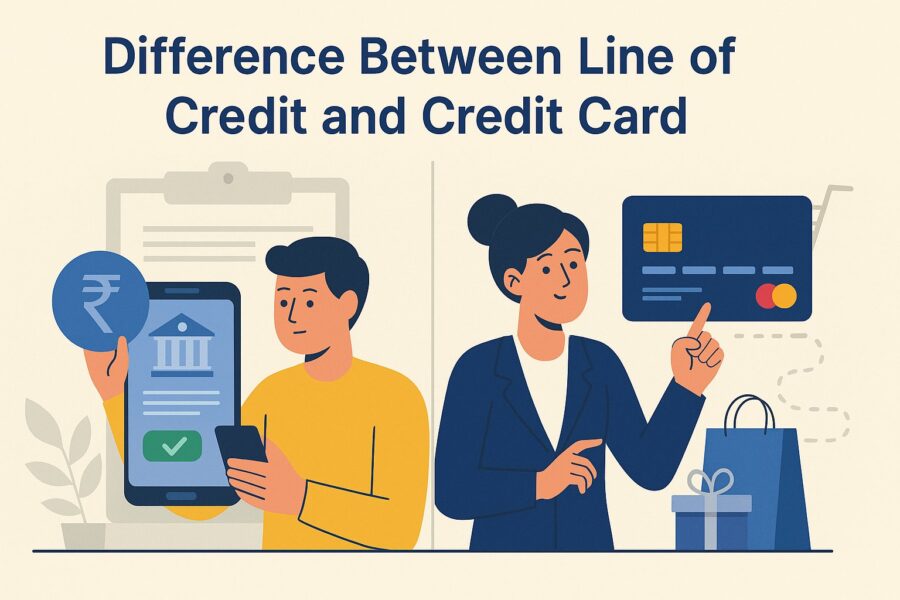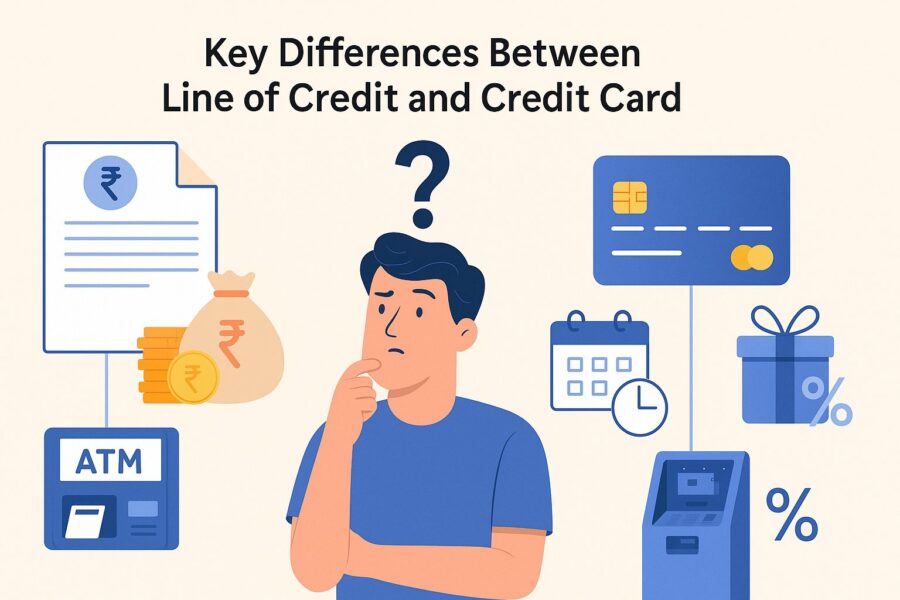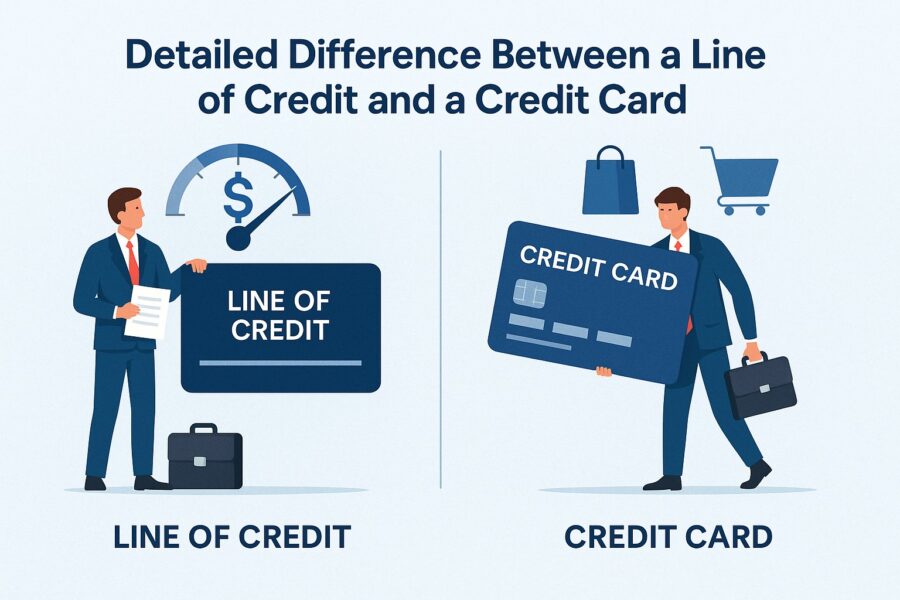What is The Difference Between Line of Credit and Credit Card?
- 16 Oct 25
- 9 mins

What is The Difference Between Line of Credit and Credit Card?
Key Takeaways
- A line of credit provides access to a pre-approved limit for flexible borrowing, ideal for large or recurring expenses. A credit card, however, is designed for everyday transactions and offers additional benefits like cashback and reward points.
- With a credit line, funds can be directly transferred to your account and up to 100% of the limit can be withdrawn. In contrast, credit cards usually allow only partial cash withdrawal and require physical or digital swiping for usage.
- Borrowers using a credit line can repay in lump sums or instalments with interest charged only on the borrowed amount. Credit cardholders must make monthly minimum payments, with interest applying to unpaid balances.
- Interest on a credit line is typically variable and can be lower for large amounts. Credit cards generally have fixed, higher interest rates, along with annual and joining fees for premium benefits.
- A line of credit is suitable for businesses or individuals managing large, irregular expenses, while a credit card is ideal for frequent purchases, online payments, and short-term borrowing.
Feeling confused by the overwhelming number of options available for borrowing money in 2025? From credit cards and personal loans to pay-later apps and beyond, the list keeps going!
The two most popular choices currently, though, are credit cards and lines of credit. But what’s the difference between the two? Credit card availability is expected to touch down on the 200 million mark by FY 2028-29, as claimed in PwC’s ‘The Indian Payments Handbook’.
So, as the credit landscape continues to evolve and expand, it's essential to be aware of the key difference between a line of credit and a credit card.
Key Differences Between Line of Credit and Credit Card

When it comes to choosing between a credit card and a line of credit, the final decision shall benefit from considering several factors. Especially, in case neither of the options imposes ongoing/annual charges, and both are essentially forms of credit, their unique features shall make them beneficial under varying circumstances.
The table below mentions the difference between a line of credit and a credit card:
| Point of Difference | Credit Line | Credit Card |
| Meaning | Businesses/persons are able to access amounts up to a credit limit that is a pre-set limit. Can be used for different business expenses, like: Purchasing inventory Meeting operational costs· Management of cash flow | A credit card is issued to the business/person by the bank. Used by businesses for online transactions, like: SaaS subscriptions Marketing expenses Cloud services |
| Fees and other charges | No joining fee/annual fee | Joining fee/annual fee is applicable |
| Usage | Funds can be accessed and used immediately after approval, even without a physical card | One must wait till the physical card is delivered (may take 5-7 working days) |
| Repayment Requirements | Payments made with reference to the borrowed amount Can choose to repay the amount in instalments/as a lump sum | Monthly payments are required Options to pay either the minimum balance or the whole (pending) amount |
| Cash Withdrawal Rule | You may withdraw up to 100% of the cash against the credit limit available | You cannot withdraw 100% of the cash against the credit limit available |
| Rate of Interest | Varying interest rates apply to the amount borrowed | The interest rate charged on the borrowed amount is fixed |
| Credit Limit | Usually higher for businesses/persons | Usually lower for businesses/persons |
| Accessibility | Accessible via different mediums, like: Direct transfer Online banking, etc. Funds are available as per the requirement, within the credit limit | Accessible via a physical card/digitally Funds are instantly available up to the credit limit |
| Purpose | Management of daily business operations Dealing with fluctuations in cash flow Funding major business needs | Online expenses for businesses Convenient payment medium Earning rewards/points |
| Best for | Businesses which have more financial needs Serving companies that seek a greater degree of financial flexibility | Businesses that have financing requirements occasionally To serve the need for easy transactions Large purchases which are not associated with clear costs |
| Other features | Overdraft protection Cheque-writing flexibility Direct payment mediums | Rewards programs cash-back offers travel benefits, etc. |
| Top-up Loan Option | An option for a top-up loan exists with the credit line. | No option for a top-up loan exists with the credit card |
💡If you already have a credit card, use the PICE App to pay your credit card bills in an easy and secured way.
Detailed Difference Between a Line of Credit and a Credit Card

Credit cards shall be better suited to meeting a company’s regular expenses, thanks to rewards and available purchase protection options. An extended payment period also helps.
On the contrary, a credit line shall be a smarter choice for larger projects that are ongoing/to cover other huge expenses. This is because the credit line allows for availing bigger amounts (lower interest rate accumulation over time).
Let’s discuss the further differences between a line of credit and a credit card in detail below:
1. Meaning
A credit line extends access to an amount that is predetermined. This amount can be borrowed as per requirement. It is a flexible financing option, allowing the borrower to withdraw the necessary amount up to a credit limit (pre-approved). They only have to clear the interest on the borrowed amount.
There are different subcategories of credit lines, like business lines of credit and personal lines of credit. Even government-backed credit lines have their unique functions.
On the other hand, banks issue the credit cards; you get to proceed with transactions up to a specific credit limit. A certain interest on the amount you use will be charged on a monthly basis. To avoid the ‘defaulter’ status, you must pay off the owed amount within a specified time period to your bank.
In the case of businesses, the business credit card plays a significant role. A business credit card is particularly made for businesses and their employees. This card can be used to manage various business operations-related expenses. It is essentially similar to a personal credit card. However, its features and benefits are supposed to meet business needs specifically.
2. Advantages & Disadvantages
| Financing Option | Advantages | Disadvantages |
| Credit Line | You get to pick what amount to borrow Best for short-term expenses Withdraw up to 100% of the determined credit limit Flexible repayment options for the borrowed funds | Required to pay maintenance fees regardless of whether or not you use the card Variable rate applicable on the line of credit sees hike in case the interest rates rise One naturally ends up spending more due to quick access to funds Typically, the interest rates applicable to the borrowed funds are higher than those associated with fixed-rate loans |
| Credit Card | Most credit cards offer a zero-interest payment tenure (30 - 50 days) Access to incentives upon completing major purchases/payments with the credit card | Most credit cards charge a big fee for cash withdrawal High interest rates will apply if one does not clear their credit card dues/payments on time |
3. Qualifications of Borrowers
You can get a line of credit if you have a checking account with the credit union, credit card companies or a lending financial institution.
On the other hand, to get approved for a credit card, you are not required to already have a pre-existing account with the credit card issuing company. In both cases, though, you must prove your creditworthiness as a potential borrower.
4. When to Use
Lines of credit can prove to be more convenient when you are required to cover large purchase costs. When the associated costs cannot be communicated in a clear-cut manner, lines of credit may be more useful. Such scenarios include:
- Weddings
- Renovations
- Medical Expenses
Credit cards are convenient and flexible alternatives to cash payments. Use your credit card to:
- Make regular purchases
- Meet unexpected expenses
- Finance bigger purchases spontaneously
5. Impact on Credit Score
Credit cards highly impact your credit score, depending on various factors like credit utilisation, payment history, credit history length, etc. You must actively take initiatives to maintain a good credit score by completing timely repayments and maintaining a credit utilisation ratio below 30%.
On the other hand, if you apply for a credit line, your credit score will possibly go down by a few points, temporarily. This is because your lender initiates a hard inquiry/hard pull to collect the necessary insights with the aim of determining your creditworthiness.
Conclusion
Knowing the difference between a line of credit and a credit card allows you to make informed decisions regarding which option suits your or your business’s financial requirements best. Both extend convenient funding access. However, by opting for the right tool as per your unique circumstances and financial situation, you’ll be able to manage your expenses more efficiently. Thus, achieve your long-term financial goals with ease.
 By
By 

















